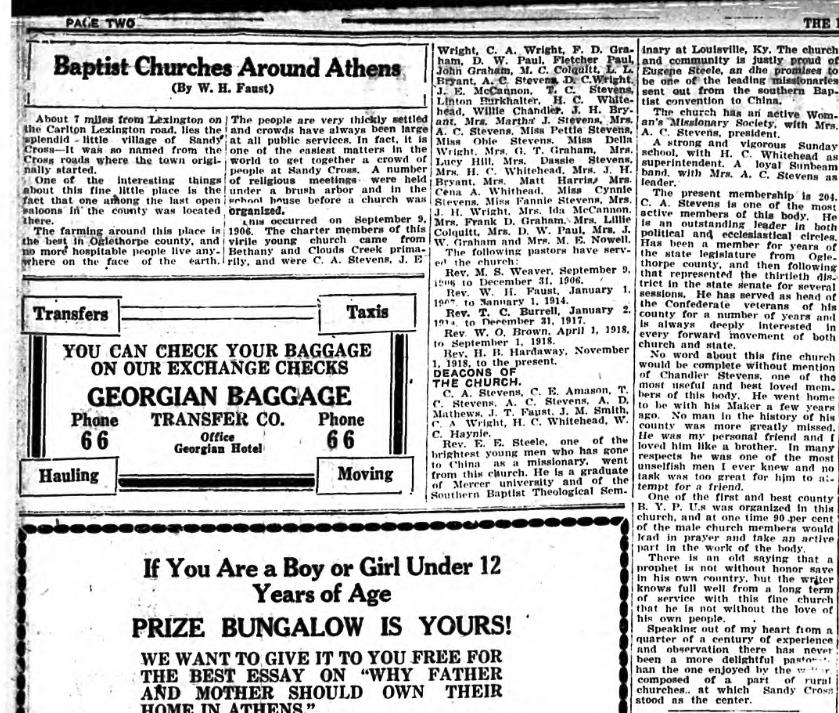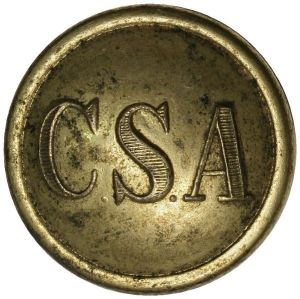John CG Stevens
You have heard the stories, a man comes home from war to die in a peculiar accident at home. Now that I have your attention, I have one of those for you today. It didn’t happen for 48 years later, but it did happen.
John Cylvanus Gibson Stevens “JCG,” was my first cousin 4x removed. That sounds pretty far removed at first. But, you have to go back to the time period in which he lived to understand that is closer than it appears. Several ancestors’ families lived in Oglethorpe County, Georgia. Later, when the first post office was established in 1867, it would be called Sandy Cross.
According to an article regarding Georgia Place Names, Sandy Cross was “so named on account of the white sandy soil found here, and because several roads crossed here, going in the four directions of the compass (Krakow, 1975, p. 198).”
My ancestors lived and farmed here and established businesses here. As a result they also grew up with each other, went to war from here, married here.
Upbringing
John Cylvanus Gibson Stevens was born 12 January 1840 to Jasper Henry Stevens and Mahala Smith in Oglethorpe County, Georgia. He was the 2nd of five children born to them. It is safe to assume that he stayed relatively close to home until he went off to war. In the 1850 US Census, he was listed as having attended school as was his older sister Susan. His father was listed as owning 1000 in real estate.
By the 1860 Census, he was listed as living with his parents and working on the family farm. He was 20 years old. His father’s estate had grown as well. He had $2,500 in real estate and his personal estate was valued at $4,500.
Two years later he would join the Confederacy.
Civil War 1862
Over the years of writing my blog, I have learned that Whitehead and Stevens cousins served alongside each other in the War Between the States. For example, JCG’s his first cousin Columbus Augustus served alongside him. George Wiley Whitehead, neighbor at the time also served alongside JCG. George Wiley Whitehead’s son, Walter Everett Whitehead, would eventually marry a Stevens, Luna Mae, whereby linking these two families together in both business and family. Interestingly, JCG’s father joined the Rebellion much earlier, 1861. He was ultimately wounded in action and sent home in July 1864 (Stevens, 1973).
JCG enlisted on 4 March 1862 as a Private in the Echols Light Artillery. Three days after Echols Artillery was organized.
According to his Muster Roll for July and August 1863, he was absent due to being sick. They indicated that he was at his home since 1 August, 1863. Not all Muster Rolls were found. The last one for JCG indicated he was Absent without Leave as of 10 December 1864. I do not know the reason for his absence. Desertions increased during the final months of the war.
Historians have argued over the proper way to interpret the act of desertion –whether it should be regarded as a protest against the state or a reaction to the specific and immediate problems that soldiers faced (such as inadequate rations, excessively strict officers, etc.)(Sheehan-Dean, 2015).
My family is lucky to have some first-hand accounts that have been preserved in writing over the years about how really bad it was for the Confederates at the end. In the book, This They Remembered, the author writes about four different Confederate Companies from Oglethorpe County that went to war. At one point the author writes:
In the short space of six months the company had been transformed from the finest and most robust body in the service to a company of weak and sallow invalids.
(Johnson, 1986, p 122)
The Echols Artillery at this time had been reduced to forty-three men, rank and file, all being in feeble health from the effects of two years’ service in Florida.
(Johnson, 1986, p.125)
After the War
JCG married his wife, Susan Pinkey Graham on 13 February 1868 (Family Search, Georgia Marriages). In the 1870 US Census JCG and Susan were living in Oglethorpe County (Post Office: Maxeys) and Susan had just had their first child, Alex. He is listed as a farmer. Remember, this was in the middle of Reconstruction.
In the 1880 US Census, JCG and his wife were still living in Oglethorpe County. Alex is no longer listed on the census (it is presumed he died in 1871, I am still looking for confirmation). Children: Blanche (6), William (4) and John L (1).
By 1885, he and his cousins, Columbus Augustus Stevens (C.A.), and Joseph Reese Stevens (J.R.) owned a store, mill and cotton gin in the village of Sandy Cross. The first name of the firm was called Stevens and Company (Stevens, 1973). The firm grew in prosperity and also in the number of firm members including more family members.
Of course, we do not have the infamous 1890 US Census as it was destroyed by fire in the 1920’s.
In the 1900 US Census, JCG and his wife Susan are living in Oglethorpe County (Grove Creek District). He is now listed as a merchant and living in a house and not a farm. Their five youngest are still living there. Willie (24), working as a general salesman (this is likely the family business). Twins girls, Essie (19) and Bessie (19) are living at home. Ernest (17) and Pearl (12), are listed as still attending school. In this census, we learn that Susan had 11 children born, but only seven are still living.
According to the Steven’s book, JCG sold his interest in the store properties and land to Walter M. Martin, the brother of another firm member in 1908 (Stevens, 1973). He was 68 years old.
In the 1910 Census, JCG and his wife Susan are now 70 and 64 years of age respectfully. The only children that remain in the home is Essie (28) and Pearl (22). JCG now lists his occupation as Farmer, owning his own farm. The census also tells us that he owns his property free and clear.
Now his peculiar accident.
My cousin Charlie, whom I have gone exploring backwards with and has the same genealogy virus that I do, sent me an article the other day that he found while search microfilm at the University of Georgia. In the article we learn that JCG and his wife had been to Comer, Georgia and was on his return home when the engine of the car stopped. JCG got out of the car to hand-crank the vehicle, and it plunged forward and ran over him. Poor Susan Stevens was still in the car and remained until the car “ran against an embankment”. Unfortunately, he did not survive his injuries, he was 72 years old.
I have included a copy of the article and a short video so you can see the position in which he found himself in.

My exploring backwards goal is to create small vignettes and hopefully weave them into a family history book for all of us to enjoy. But, alas, I am not yet retired, so it has been slow going. Thank you to all of you that give me the encouragement to keep plodding away.
Sources:
“Georgia Marriages, 1808-1967”, database, FamilySearch (https://familysearch.org/ark:/61903/1:1:FW7P-TZH : 11 January 2020), John C.g. Stevens, 1868.
Johnson, Mary N. (1986). This They Remembered: 1861-1865. Washington Publishing Company, Ga: Brentwood University Press.
Krakow, Kenneth K. 1975. Georgia Place-Names: Their History and Origins found at http://www.kenkrakow.com/gpn/s.pdf
Sheehan-Dean, A. Desertion (Confederate) during the Civil War. (2015, October 27). In Encyclopedia Virginia. Retrieved from http://www.EncyclopediaVirginia.org/Desertion_Confederate_during_the_Civil_War.
Stevens, Claude G. “The Stevens Family, John Stevens Line,” Commercial Printing Company, 1973.
The Oglethorpe Echo, Volume 40, Number 19. “Mr. John G.C. Stevens is Killed by His Auto” sent to me Charlie Snelling after finding it in the microfilm at the University of Georgia.



























